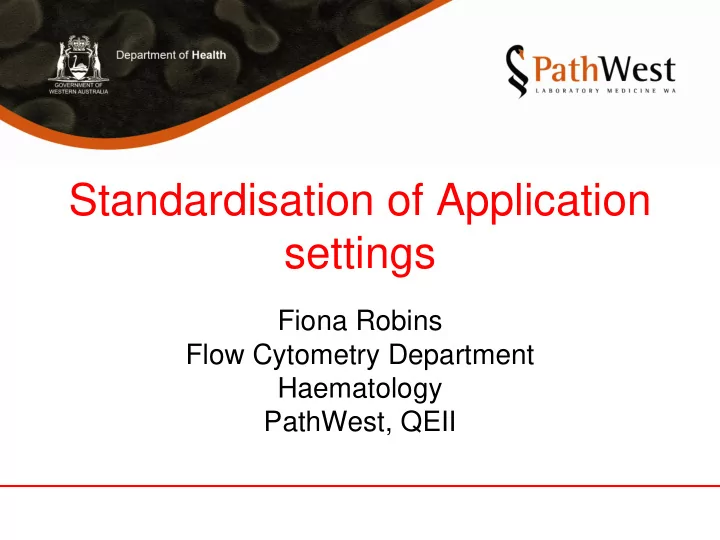

Standardisation of Application settings Fiona Robins Flow Cytometry Department Haematology PathWest, QEII
PMT voltage applied to photomultiplier tube rCV dim beads, rSD dim beads, Optimal PMTV = 10 x rSD EN
Optimisation of Voltages to be used for patient samples (lymphocytes ) • The CS+T bead report can be used to calculate targets and ranges that are then used to determine the optimal voltages for running human blood cells.
Record the electronic noise robust SD and the linearity maximum channel from the baseline report to use for creating the application settings Minimal rSD dimmest cells equals the rSD electronic noise x 2.5
Creating Application Settings
Baseline data • Determine the minimum PMT for each detector based on 2.5 x rSD of electronic noise • Make sure there is a good use of dynamic range • Check that high positive cells will be within the linear range (MFI is below the maximum linearity value). • Save to catalogue as application settings
CS+T beads Used to monitor the instruments performance and adjust voltages to maintain standardised settings over time in the same instrument. Application settings are automatically updated in a catalogue when the CS+T beads are run (daily) and can be applied to an open experiment in Diva
Alexa Fluor for 3 dates CS+T AS CST gain Total Gain FITC PMTV PMTV on PR for AS 498 21-Sep 27-Sep 14-Sep 496 490 0 Baseline 496 14-Sep 19-Sep 493 487 -3 minus 3 494 19-Sep 21-Sep 497 491 1 plus 1 492 PMT values 21-Sep 27-Sep 27-Sep 497 491 1 plus 1 490 14-Sep FITC CST 488 19-Sep baseline 496 CS+T 486 Application settings 484 482 PE for 3 dates CS+T AS CST gain Total Gain PE PMTV PMTV on PR for AS 422 14-Sep 418 420 1 Baseline 421 21-Sep 27-Sep 19-Sep 416 418 -1 minus 2 420 14-Sep 21-Sep 419 421 2 plus 1 419 21-Sep 27-Sep PMT values 27-Sep 419 421 2 plus 1 418 14-Sep 19-Sep CS+T Application Settings 417 PE CS+T baseline 417 416 19-Sep 415 414 413
Application settings • PMT voltages saved as Application settings for Lymph/Leuk analysis as 6 and 8 colour experiments, and other applications such as FMH,PNH and stem cell analysis have specific application settings • Application settings are updated daily in the catalogue when the CS+T beads are run • Diva 6 does not automatically update Application settings in the saved Experiment templates so this must be done manually. • Compensation settings remain the same when App settings are updated.
Importing App settings • AML/MDS App settings are imported/applied every time the experiment is run (8 colour settings). • Lymphoma settings are updated when compensation is run monthly and are linked to the templates. • All other experiment and panel templates have settings updated manually at the beginning of each month. • Diva 7 will update the settings on templates automatically when the CS+T beads are run (daily)
Note: When importing App settings into an experiment or panel that has been saved as a template there is an option to keep the saved compensation settings.
Tracking Aim is to establish standardised Instrument settings that allow reproducible measurements (identical or at least highly comparable)
CS+T lot changes • The old lot must first be run for a performance check to obtain current voltage settings. • The current voltages must be manually adjusted when running the baseline for the new lot of CS+T beads. • This is essential to maintain consistency in the Application settings over multiple lots.
Consistency - At different times in the same instrument
Consistency -In different instruments in same lab or at another site • Requires reference beads • Rainbow particles and CS+T (bright beads) used by QEII to adjust voltages. • CS+T bright beads can be used to monitor the App settings. • 8 peak rainbow beads. (Euroflow protocols)
Protocol • Beads (run 10 to 20 times then calculate the average MFI) on Cytometer 1 to create defined scatter and MFI values • Beads run on Cytometer 2 The voltages are adjusted to give the same scatter and MFI values and then saved as App settings in the catalogue
An example of a global worksheet when CS+T beads are acquired to create target values. The CS+T bright beads are gated in the FSC SSC plot The target value for each parameter is displayed in the statistics view showing the median. Record bead lot on the template
Monitoring • Target for each detector based on the mean value for 20 runs with our 8 colour application settings. • Monitor settings daily • Excel spreadsheet with MFI for all detectors used to monitor our 8 colour settings. • Results for both instruments in Levey-Jennings charts stay within 15% of MFI target. Euroflow Standardisation of Flow Cytometry Protocols Kalina T et al, Leukaemia2012 . • • Compare the mean and CV for both instruments
FITC MFI for both instruments in Levey-Jennings charts FITC Sept 6- Nov 5 2012 28000 27000 26000 25000 Upper Limit Target 24000 Lower Limit 23000 TIM DataPoint TAM Data Point 22000 21000 20000 19000 FIXED DATA SET TIM DATA TAM DATA 15% Target 3548 2SD Set 3211 2SD Set 1373 Upper Limit 27203 Upper 2SD 27999 Upper 2SD 26131 Target 23655 Mean 24788 Mean 24758 Lower Limit 20107 Lower 2SD 21577 Lower 2SD 23385
Monitor the CV for each detector on both instruments TIM TAM % CV % CV FSC 5.55 2.45 SSC 5.30 2.92 FITC 6.48 2.77 PE 6.95 2.94 PerCP-CY5.5 5.86 3.51 PE-Cy7 6.17 4.57 APC 2.52 1.99 APC-H7 2.79 3.91 V450 2.23 1.44 V500 2.18 1.61
TIM TAM
Recommend
More recommend